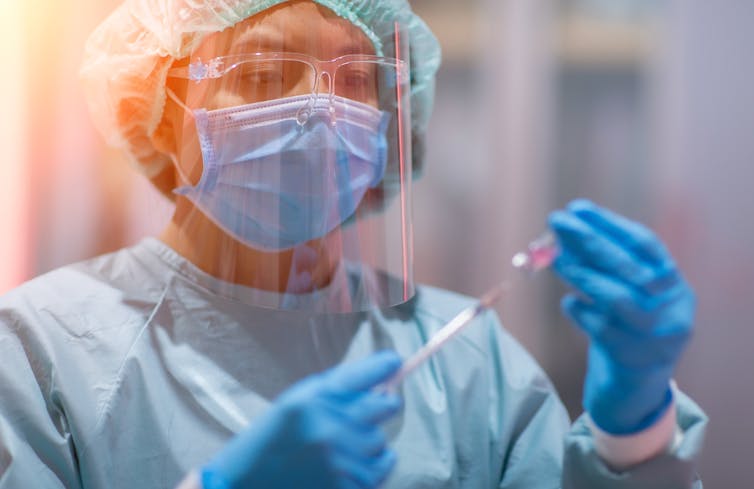Counterfeiting – the underworld threat to beating COVID-19

Counterfeit vaccines, testing kits, and vaccine passports are undermining the global fight against COVID-19. AnaLysiSStudiO/Shutterstock
Courtesy of Mark Stevenson, Lancaster University
While the word “counterfeit” may conjure up images of fake cash and knock-off handbags, the pharmaceutical industry – and with it, the fight against COVID-19 – has been significantly affected by illicit goods.
In a major operation, Interpol recently intercepted global counterfeit rings, closing more than 100,000 bogus online pharmacies, making nearly 300 arrests and seizing more than US$20 million (£14.2 million) worth of counterfeit items in the process. Mainly targeting counterfeit COVID-19 testing kits, this operation followed other examples. These have included the discovery of counterfeit networks in China and South Africa and the production of fake vaccines from simple, widely available ingredients such as saline solution and mineral water.
Despite these law enforcement breakthroughs, the world’s fight against COVID-19 is being undermined by a booming trade in counterfeit PPE, COVID-19 testing kits, vaccines, vaccine passports and other products that are contributing to the spread of the virus.
The appeal of fake vaccines
Pharmaceutical markets are worth more than US$1 trillion (£710.2 billion) annually, making them an attractive target for counterfeiters, who often trade anonymously via online auction sites or pharmacies.
There are many reasons why counterfeit COVID-19 vaccines in particular are emerging, including the high and instant demand – which has outstripped supply during the pandemic. This has not been helped by the expense of developing vaccines at a national level, affected by the high research and development cost behind producing a genuine product, which has made access difficult, especially for poorer countries. This has ultimately led to unequal global access to vaccines, with much of the world’s supply being controlled by the most powerful countries.
Meanwhile, the relative ease of producing a fake, which might potentially only be detectable as not genuine when it fails to protect someone from the virus, means the barrier to market entry can be relatively low.
The consequences of consuming fake products when they are safety critical, as in the case of an injected vaccine, can of course be significant – and there are many historical cases of fake pharmaceuticals, such as cancer and anti-malaria drugs, causing death. Other than being potentially toxic, the fake may contain none of the active ingredient, or a diluted amount that fails to have the intended effect.
For other COVID-related products, such as fake vaccine passports and testing kits, the health implications for the individual may be more indirect. There, demand is arguably driven by a desire to get back to “normal” life, despite the potential to infect others and disrupt efforts to reduce COVID-19 transmission.
While the impact of counterfeiting on the stubborn persistence of the pandemic is difficult to measure – and is more of a factor in some countries than others – it is likely to be contributing to new waves of the virus, and is having a detrimental effect on the global fight against COVID-19.
Now Amazon is selling counterfeit COVID-19 vaccination cards https://t.co/GgqaopXqyy pic.twitter.com/B9mcHhao4f
— Olivia Little (@OliviaLittle) June 7, 2021
Counteracting the threat
Counterfeiters present a shifting threat, and by nature of operating digitally can be difficult to detect. There are, however, potential countermeasures for dealing with the threat they pose.
While some technological developments such as the internet may have exacerbated counterfeiting, others, such as radio frequency identification tags and blockchain technology, can help to distinguish genuine products and confirm their provenance. Furthermore, just as counterfeiters can present a moving target for prosecutors, genuine producers can make their products harder to replicate by regularly changing product and packaging designs, and by educating consumers on how to spot a fake.
In many countries, the vaccine rollout is heavily orchestrated and regulated, meaning it should be relatively straightforward to avoid counterfeit vaccines at the point of consumption by sticking to authorised channels, providing they do not infiltrate the genuine supply chain, such as at distribution centre level. In late 2020, as vaccination programmes began, authorities warned of the threat posed by counterfeiters who were likely to attempt infiltration.
It may, however, be that consumers in some countries are willingly seeking out COVID-related counterfeit products. While it is good news that some of the world’s superpowers are now aiding in the global supply of vaccines, customers need to be educated on the dangers of buying counterfeits. Additionally, the purchasing of counterfeit products often funds other forms of organised crime.
Given that counterfeiters of vaccines and other related products may infiltrate the supply chains of genuine producers, firms also need to take a closer look at their own practices and increase their supply chain vigilance. For example, it may be wise to work with a smaller number of local, trusted suppliers and to limit supplier involvement in product development in order to minimise the risk of design and production knowledge leaking outside the firm.
Arguably the most effective action against counterfeiting in general will be a collaborative one. This includes supply chain partners, rival firms, consumers and authorities working together to detect counterfeits, share intelligence and consistently prosecute offenders.
Just like a global response to the direct threat posed by the virus is needed, a global response to the scourge of counterfeiting is needed. This underworld threat may otherwise delay the world’s return to (new) normality.![]()
Mark Stevenson, Professor of Operations Management, Lancaster University
This article is republished from The Conversation under a Creative Commons license. Read the original article.



